Revolution #216, November 14, 2010
Correspondence / Additional Coverage from the National Day of Protest Against Police Brutality, Repression and Criminalization of a Generation, 2010
Editor’s note: In addition to coverage elsewhere in this week’s issue, Revolution received the following letters from activists and participants in O22.
Harlem—Bearing witness in the park
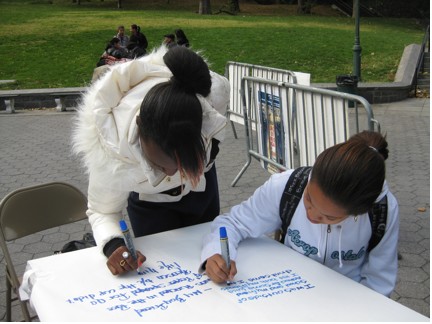
In the days going into October 22 a new wind blew through a park in Harlem and into the cluster of nearby high schools and junior highs, and a college. Black and Latino students as young as 12 years old responded to the call from Revolution newspaper for them to bear witness—to tell their stories about police brutality, abuse, and degradation. Over the course of the week what emerged was a gut-wrenching picture of the commonplace and outrageously oppressive treatment these young people are subjected to by the police.
Stories were transcribed from two or three-minute audio interviews, recorded as students were on their way to school in the morning. Then the stories were printed and distributed in the park. Day two—two stories. Day three—four more stories. Day four—three more. This became a huge social question. Students told us their teachers and fellow students were reading the stories aloud in classes. Discussion was being stirred and more stories were being told. Questions were being asked, among them, "Why do the police do us like this?" and "Can things really be different?"
Everybody was being challenged to wear black and bear witness on O22.
On October 22nd, seven stories from Harlem youths were hand written on large boards and posted at a park. Enlargements of Revolution newspaper centerfolds were put on view: the police murder of 7-year-old Aiyana Stanley Jones and the brutal rape and murder of 14-year-old Abeer Qasim by U.S. soldiers in Iraq; the Stolen Lives Centerfold with the faces and names of others murdered by the police. Passersby joined people who had come for the Speak Out and read the stories with recognition and smoldering rage. Still others read in shock. "Is it really this bad?"
At times the scene in a little plaza at the bottom of a hill buzzed. Revolution reporters, students from near by City College of New York, joined others to record interviews. Three and four interviews were going on at a time as one heartfelt recounting after another came from youth and adults. Young people hovered over a swath of butcher paper spread across a table intently writing. More stories of police cruelty and abuse poured onto the paper. Interest and enthusiasm built around a table with information and organizing materials for the October 29th Carl Dix, Cornel West Dialogue "Police Terror, Incarceration, No Jobs, Mis-Education- What Future for Our Youth" while others talked about the upcoming Constitution for the New Socialist Republic in North America and the possibility of a different kind of society and future.
At one point 20 or so people gathered into a loose circle that grew ever tighter as one person after another spoke. The People’s Neighborhood Patrol, which has patrolled the streets in Harlem over the last year read a proclamation declaring that it would continue to witness, call out, and stand up to any and all illegal actions by the police against the people.
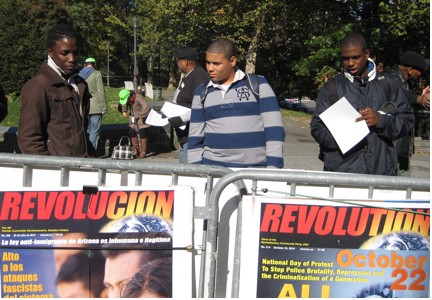
The proclamation began with:
"The days when this system can just keep on doing what it does to people, here and all over the world, when people are not inspired and organized to stand up against these outrages and to build up the strength to put an end to this madness... those days must be GONE. And they CAN be."
People were excited by the fact that this declaration is being acted on in this way—with a plan connected to building the movement for revolution. Several people signed up and went out with the next patrol.
Half the people in this circle spoke. Two Black students from CCNY, a young immigrant from Ecuador, a young white woman who had found out about the speak out that day, a high school youth, a Revolution reporter spoke about the police murder of 20 year old DJ Henry at Pace University only a few days earlier, and a person spoke for the Revolutionary Communist Party about the system that produces all this madness and the movement for revolution we’re building now as part of the preparation to make revolution and put an end to all this.
By the end of the Speak Out everybody involved felt that something very important had happened. Two Latino high school students who had checked out the event from beginning to end stood in front of the What Future for Our Youth? table pooling their money. "Four, five…." They put together to get one "This System Has No Future for the Youth—But Revolution Does" T-shirt. "This is awesome," one of them said. "I want to join this."
Cleveland – "No we won't have this… Stand up!"
Sixty-five people, mostly youth, came out to protest police brutality, repression, and the criminalization of a generation. As people assembled in downtown Cleveland, black armbands were passed out along with the October 22nd Calls, and "The Revolution We Need... The Leadership We Have" Message were gotten out among the throngs of youth waiting for a bus.
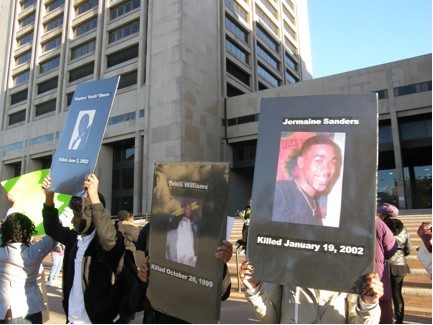
Then parents who lost young Black men spoke about the horror they feel. Alesia Kirkman, who lost her 17 year old son who was unarmed, said, "We have to do something to stop the police from killing our young men and harassing our young daughters. We have to do something."
Tina Bronaugh, mother of two high school students who were viciously beaten and charged for protesting school cuts and layoffs, spoke passionately about that case and called for people to stand up to it. "They were attacked by the police, thrown to ground, they had knees on their backs and necks... Why for a peaceful protest. You tell me why! Because they wanted to stand up for something they believe in. No we won't have this, we won't have this going on against Black kids, givin' them records throwing them in jail for nothin', we won’t have this. Black people white people Chinese people stand up! Stand up!"
A supporter of the RCP spoke about how "we need a revolution and a revolutionary movement to get to a whole different world...which will unleash the creativity, energy and thinking of the youth, not pen them in and crush it all...there is a movement for revolution that youth and others can get into right now…"
Then people took off and marched to the "Justice Center," where prisoners waved from the windows hearing loud chanting and then the march went through an entertainment district in which Blacks have been repeatedly profiled and then harassed, and arrested. People along the way got Revolution papers and Message/Calls and asked people about the protest, others honked their horns in support. Along the way, "Killer cops in every town, We won't forget, We won't back down!" was shouted loudly for everyone to hear.
At the end, parents and others spoke about how to end police brutality and murder. There is a determination among the youth and others to build a movement of resistance to stop police brutality, repression and the criminalization of a generation.
Seattle – in the wake of seven police murders in two weeks
In Seattle O22 was built off of widespread outrage at seven murders by police in the state in a two-week period in early September, including the killing of Native American wood-carver artist John T. Williams. In the days leading to O22 posters put up at Seattle Central Community College (SCCC), where the protest was to start, listed stolen lives by police and their stories, told people October 22nd was a national day to take this on and challenged people about where they would be on that day.
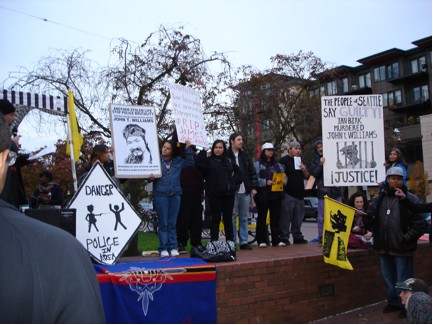
People at the rally were visibly affected by moving testimony from the families of Richard Simms, David Young, James Whiteshield and friends of John T. Williams—all recently murdered by police or jail officials. One young man in tears said hearing these stories left him heartbroken, but he was moved to think about what he could contribute to stopping this and to the cause of revolution. One young Black girl held up the printout from revcom.us of Aiyana Stanley Jones, one of the Stolen Lives and said, "She was 7 years old, like me."
A speech from a correspondent for Revolution newspaper put revolution into the air, onto people’s lips and helped set a very defiant and resistant mood and provoked debate and controversy over revolution and communism. The Party's Message and Call was very broadly distributed.
A mix of nationalities was brought together—mainly youth but with some older people. There were crews of white proletarians who were friends and family of David Young, students of many different nationalities from SCCC, Native proletarians who were close with John T. Williams, and a crew of young Black girls from a church ministry who carried the O22 lead banner.
The feeling of anger and that people were sick to death of this police murder poured out into the streets—a palpable unleashing of defiance. Youth called out the police all along the way, and challenged others to come into the streets, which dozens did. There was a spirit present among people of refusal to let police murder and brutality stand, and of real uplift. Some 300 people took the streets. One chant was "Killer cops are guilty, guilty, the system is filthy, filthy". At the site of John T. Williams murder hundreds did a die-in blocking intersections and dozens carried the protest into the night into the streets of the Capitol Hill neighborhood. A number of youth commented they had never been on a march that felt like this.
Chicago – Sharp contention at a high school
Oct 22nd, Chicago. Noon – and a yellow school bus pulls up just short of the banner stretched across the corner of the Plaza. The banner announces the National Day of Protest to Stop Police Brutality, Repression and the Criminalization of a Generation.
The crowd gathered in the plaza cheers as students pour off the bus, together with some of the teachers and staff from their alternative HS. They are carrying signs created in friendly competition between classes at their school. In a few minutes some will read poetry and statements.
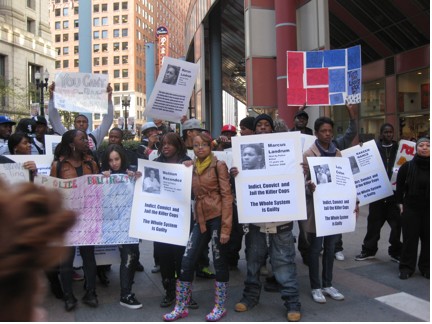
Already in the plaza: people from Chicago’s southside ghetto, other high schools, and colleges who had a flyer handed to them or read it on a wall; families of people killed by police; activists around issues of police brutality, war and racial injustice; revolutionaries, communists, anarchist youth and religious activists. People hold stolen lives posters overhead—pictures and descriptions of dozens killed by police in Chicago.
Groups pose for pictures in front of the banner. People want a record of their involvement with this protest. Even as the plaza was being set up for the rally a group of students from Canada coming through had posed for pictures with stolen lives posters.
In the plaza literature is distributed – October 22nd flyers, Revolution newspaper, and the Message and Call from the Revolutionary Communist Party, stickers with the graphic "Danger: Police in Area." A young man and woman stop to tell about their cousin, killed by the police two years ago. They join in with the protest. In the plaza, along the edges, walking past or coming through on the way to lunch people stop to tell those distributing literature their own stories of run-ins with the police.
The day’s rally starts with a roll call of stolen lives followed by the recognition of Stolen Lives families in attendance. Students read poetry and a powerful speech on "fighting Police Brutality and transforming the people for revolution" is delivered from a representative of the Chicago branch of the Revolutionary Communist Party.
A student introduces himself as "a young revolutionary" representing his school. He details what people face daily across the U.S. at the hands of the police – physical and verbal abuse, hit with night sticks, tazed, guns stuck in people’s faces, homes and vehicles illegally searched. He lays out the need for people to act to do something about it! This student has proudly brought his mother out to hear him speak at the rally.
As the rally ends participants take off in a powerful, enthusiastic march that surges down State Street and back up Michigan avenue—drums pounding and chants echoing through the canyons of the Chicago Loop in the midst of lunch rush hour. Led by a banner with the pictures of 22 people murdered by the Chicago police, the mainly young and predominantly Black march meets strong encouraging (and encouraged) greetings from the basic masses. It meets curiosity, interest and some support from many of the middle class people along the route. The youth make sure that people know what they are in the streets about – holding stolen lives posters against the windows of restaurants and cafés as we march past. There are 75 to 100 people marching, the number rising and falling as people join in off the streets to march for a few blocks before dropping back out.
In the course of building for October 22nd new things came forward. Going into one alternative school you got a sense of anticipation for the day. Teachers in the hall talked about what their classes were doing for the day. On a classroom door – a homemade poster demanding "Stop the Criminalization of a Generation." A teacher told us, "Every day at least one of the students doesn’t have their homework done because they spent the night before in custody." She put together a Powerpoint presentation from the October 22nd National Web Site and had used the Revolution newspaper stories on police murders in New Orleans during the Katrina crisis as a topic of class discussion.
At an El stop, where students from this alternative school and four other high schools converge when school lets out, we set up a clothesline with a stolen lives display. Youth hanging out let us know "I’ll be there" at the protest on October 22nd.
Across town, a young man who is sometimes active with the revolution encouraged us to build for the day at a high school where his cousin goes – a place where he knows a progressive teacher who reads Revolution newspaper when the cousin takes it to school. We met the younger cousin and her teacher who encouraged her to make black ribbons for students to wear on the day – and we arranged to speak about Oct 22nd in his class.
At another school the contention was sharper. This was a school where a number of friends and relatives of Corey Harris are—Corey was shot in the back by police and killed at the start of school last year. When the school let out there was a full-scale police occupation. More than a half dozen police vehicles – including hulking SUVs and police vans. Clumps of police on the corners. Police cars blocking the streets.
Students welcomed the flyers for October 22nd and gathered around a Stolen Lives display, telling us about the people on it they had known – and not just Corey Harris. The response of the police and one of the school administrators was anything but welcoming. The administrator and the police verbally attacked us, tried to force us to move, and police issued a bunch of traffic tickets.
The week of October 22nd we returned with legal observers from the National Lawyers Guild who had volunteered to come out to the school when they heard what had happened. They were shocked when they saw the scene of police occupation. One of the cops told his sergeant "They’re back" and started over to the Stolen Lives display—the sergeant waved him off . The balance was different. A student took the centerfold poster from Revolution newspaper and defiantly paraded around, waving the poster in the face of the police.
October 22nd, evening—a rally is held at Corey Harris Park on Chicago’s Southside. About 50 people, mainly friends and family of Corey Harris, come out to protest police brutality and to remember Corey. Corey was shot by police September 11, 2009 just a few blocks from the park we gather in—a park whose backboards and basketball nets knew Corey well.
Family members and friends speak of what the official brutality of the police had cost them. People wrestle with how to respond to, what to do about, how to resist the daily brutality of the police.
Atlanta – Speak Out
October 22, Atlanta: About fifty people wore black and held signs in Woodruff Park, a busy downtown park that serves as a networking area for many of the city's homeless (many of whom are victims of police violence).
The demonstration consisted of many different organizations: FTP Movement, CopWatch, Progressive Student Alliance at Georgia State, the Revolutionary Communist Party, and Malcolm X Grassroots Movement. The event consisted of a speak out which gave voice to many victims of police brutality. Victims of police brutality shared their stories to hundreds of passersby. The demonstration ended in a short march up to the MARTA train station, people cheered as demonstrators chanted "NO JUSTICE, NO PEACE, NO BRUTAL POLICE!"
Greensboro, North Carolina – Joined by another shattered family struggling with the horribly common reality of deadly police violence.
October 22, 2010: Greensboro shook today to the sounds of beats, chants, outrage, joy, and resistance as the movement to stop police brutality, repression and the criminalization of a generation took to the streets. The planned protests against the new $114 million Guilty County jail and the rally and march at Smith Homes took on an even heavier tone this year, as early on this Friday morning of October 22nd, the day was shattered by the brutal slaying of the unarmed 28 year old Marques Burnett by Greensboro police. Organizers managed to reach the family by this afternoon, and we were once again joined by another shattered family struggling with the horribly common reality of deadly police violence.
A crowd of about 40 demonstrators, including students, families, immigrant rights activists, and the Cakalak Thunder radical drum corps, had gathered in the shadow of the jail that is under construction, and already towering over downtown. A local immigrant rights activist told of how Sheriff BJ Barnes planned to pay for this new high-tech dungeon by taking millions of federal dollars to round up immigrants under the 287g program, known by many activists as "the modern-day Fugitive Slave Act." A revolutionary activist talked about the role of jails, cops, and courts in promoting and upholding a savagely unequal capitalist system.
As we were wrapping up the jail demonstration and preparing to head to Smith Homes public housing, where another demonstration was planned, we were joined by the aunt of Marques Burnett, who saw us as she was driving by. She was embraced by the demonstrators, including a mother whose son was murdered by a Guilford County deputy in 2001. Meanwhile, across the street, a group of about 12 Greensboro cops massed threateningly in the parking lot. Protesters pointed out that we were here peacefully and intended to remain so, that we had not killed anyone—that’s the difference between us and them.
When we regrouped at Smith Homes, we were met by another of Marques’ aunts, who addressed the group honestly in spite of the overwhelming pain of her loss that very morning. She then added her nephew’s name to the Stolen Lives banner as organizers promised that he would not be forgotten. A revolutionary poet then performed an intense piece, and the mother of the young man killed in 2001 led the group in reciting the Stolen Lives pledge. We then began a loud, spirited march through all of Smith Homes, led by Cakalak Thunder and revolutionaries agitating via bullhorn for people to come down and join the march.
The website of the Coalition to Stop Police Brutality, Repression and the Criminalization of a Generation is: http://www.october22.org/
* * *
Other Coverage and Commentary on October 22nd
A variety of activities took place on October 22nd, and the day was noted by a wide range of news sources. The following links give some sense of the spectrum of those activities and reports.
The Orange County Register reported, "Fifteen activists turned out in front Friday afternoon of the Costa Mesa City Hall to denounce what they call police brutality against immigrant communities. The protest organized by Colectivo Tonantzin, a day laborer advocacy group was held in observance of the National Day of Action Against Police Brutality." (Day laborers hold rally at Costa Mesa City Hall, by Cindy Carcamo. See slideshow)
La Coop Média (The Media Coop) in Montreal reported that "members of various families who have been touched by police violence, both in Montreal and across Canada, gathered to share their stories and to call on Montrealers to join them tomorrow for a vigil in front of the offices of the Montreal Police Brotherhood (the Montreal police officers' union) and on Saturday for a family friendly march through downtown Montreal. The march is being held as part of the North American Day to Stop Police Brutality & Repression." (Vigil and march to mark police violence in Montreal, by Tim McSorley)
The Daily Iowan wrote: "They are commonly deemed 'bad apples' — a handful of bad cops among the good ones, smearing the reputation of other noble officers. But these bad apples do more than just make police forces look bad: They also marginalize minority groups and deal irreparable harm to the community. Because today is the National Day of Protest to Stop Police Brutality, it’s time to pay more attention to the way police actions play a role in the stratification of American society." (All-too-pervasive cop brutality, by Shay O’Reilly)
The October 22nd Coalition to Stop Police Brutality, Repression and the Criminalization of a Generation was mentioned in a generally negative piece on Fox News, "U.N. Human Rights Council Takes Aim at New Target: United States."
The Huffington Post wrote: "Friday, October 22nd marks National Day Against Police Brutality, a day where we raise awareness of police violence, brutality and abuse in this country and call for more humane, fair and effective policing practices. New York has been the stage for particularly horrendous tragedies of police brutality and abuse, including: the shooting of Amadou Diallo with 41 bullets as he pulled out his wallet to identify himself to the police; the assault and sodomizing of Abner Louima, a Haitian immigrant in police custody; the sexual assault of a 35-year-old Latina woman who was forced to perform oral sex on officers after being stopped for a traffic violation; the shooting of Sean Bell after his bachelor's party; and the tasing and subsequent death of Iman Morales, who was suffering from a seizure on a fire escape and died after police were called to help him." (On a Day Against Police Brutality, Let's Talk About Stop-and-Frisk, by Nahal Zamani, Education and Outreach Associate with the Center for Constitutional Rights).
Photos special to Revolution
If you like this article, subscribe, donate to and sustain Revolution newspaper.



